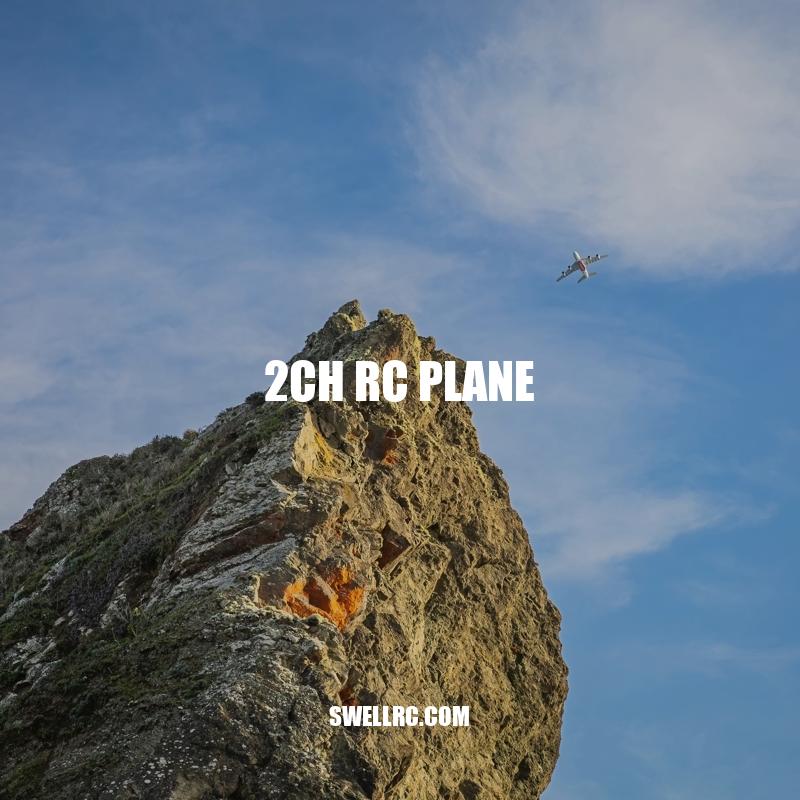Beginner’s Guide to 2ch RC Plane Flying
2ch rc planes are an excellent way to get started in the world of remote-controlled aviation. As the name suggests, these planes are controlled by just two channels, making them a great choice for beginners and those on a budget. Despite their simplicity, 2ch rc planes are capable of flying long distances and performing basic maneuvers with ease. They are also highly customizable, with many different types of planes available for purchase. Whether you’re interested in flying a glider or a propeller plane, there’s sure to be a 2ch rc plane that meets your needs. In this article, we’ll take a closer look at the world of 2ch rc planes, including what they are, how to fly them, and some tips for beginners.
2ch rc planes are remote-controlled airplanes that are controlled by a transmitter that sends signals to the plane’s receiver. These planes are relatively simple and can be flown by anyone, regardless of their experience level. Here are some characteristics of 2ch rc planes:
- They have two channels, which means they can only move up and down or left and right.
- They are typically made out of lightweight materials such as foam or balsa wood.
- They are powered by a small electric motor.
- They have a wingspan of around 20-30 inches.
- They are easy to transport and can be flown both indoors and outdoors.
- They are usually less expensive than other types of rc planes.
There are many different types of 2ch rc planes available in the market, including gliders and propeller planes. Some popular brands of 2ch rc planes include HobbyZone, E-flite, and ParkZone. If you’re interested in purchasing a 2ch rc plane, be sure to do your research and find a plane that meets your specific needs.
What are remote controlled aircraft called?
Remote controlled aircraft are commonly called “drones” or “unmanned aerial vehicles (UAVs)”. These aircraft are flown by a person on the ground using a remote control or a mobile device. Drones are widely used for recreational purposes, aerial photography and videography, surveying land and infrastructure, monitoring wildlife and agriculture, and in various commercial applications. If you’re interested in buying a drone, you can find plenty of options online on websites like Amazon, Best Buy, and DJI.
Types of 2ch RC Planes
There are two main types of 2ch RC planes: gliders and propeller planes. Here’s a breakdown of the differences between the two:
Gliders: Designed to fly without a motor, using the power of the wind.
Propeller planes: Powered by a small electric motor which propels the plane forward.
Advantages: Gliders require no fuel or batteries to fly, are quiet and peaceful, and have a less complex design. Propeller planes offer more speed and maneuverability, are able to fly in stronger winds, and give the pilot more control over speed and altitude.
Disadvantages: Gliders require the right wind conditions to fly, and can be difficult to launch without a slope or assistance. Propeller planes require batteries or fuel, make more noise, and have a more complex design that can be harder to repair.
It’s important to choose the right type of plane for your needs and interests. If you want a more peaceful and gentle flying experience, a glider may be the right choice. If you’re looking for more speed and maneuverability, a propeller plane may be a better fit. Some popular 2ch RC gliders include the HobbyZone AeroScout and the ParkZone Radian. For propeller planes, the E-flite UMX Radian or the HobbyZone Sport Cub S are both great options.
What are planes with propellers called?
Planes with propellers are commonly known as propeller planes or simply prop planes. They use propellers to generate lift and thrust to move forward.
There are several types of propeller planes, including:
- Single-engine propeller planes, such as the Cessna 172 and Piper Cherokee, which are commonly used for general aviation and flight training.
- Twin-engine propeller planes, such as the Beechcraft Baron and Piper Seneca, which are often used for business and personal travel.
- Turboprop planes, such as the Beechcraft King Air and Pilatus PC-12, which use a turboprop engine to drive the propeller and are commonly used for regional and cargo flights.
If you’re interested in learning more about propeller planes, there are several websites and products available. Some examples include:
- Trade-a-Plane: a website that lists new and used propeller planes for sale
- AOPA Pilot Magazine: a monthly publication that covers all aspects of general aviation, including propeller planes
- X-Plane: a flight simulator software that allows you to fly a variety of propeller planes virtually
How to fly a 2ch rc plane
Flying a 2ch rc plane can be a thrilling and rewarding experience. Here’s a step-by-step guide on how to fly one:
- Choose a suitable flying location. Look for an open area away from trees and power lines, and free from people or animals.
- Perform a pre-flight check. Make sure all components are connected properly and the batteries are fully charged.
- Launch the plane. Hold the plane at a 45-degree angle and give it a gentle toss into the air.
- Use the control sticks to fly the plane. The left stick controls the altitude and the right stick controls the direction. Push the right stick forward to move the plane forward, and back to slow it down or to make it go backwards.
- Practice basic maneuvers, such as turns, figure eights, and loops. Start with small movements and progressively increase the difficulty.
- Land the plane. Reduce the altitude and come in for a gentle landing. Use the left stick to control the landing speed and angle.
It’s important to note that flying a 2ch rc plane takes practice and patience. Don’t be discouraged if you crash your plane or have a hard time controlling it at first. Seek guidance from experienced pilots and keep practicing! There are also several resources available online that can help you learn more about flying 2ch rc planes, such as the RC Groups forum and the FliteTest YouTube channel.
What is the feeling of being in an airplane?
Flying in an airplane can evoke a diverse range of emotions in people. For some, it may bring about excitement and anticipation for a new adventure, while for others it may trigger feelings of anxiety or fear. Some common feelings experienced when in an airplane include:
- Excitement for upcoming travel or new experiences
- Anxiety or fear of flying
- Sense of adventure and exploration
- Impatience or boredom during a long flight
- Awe and appreciation for the astounding views and the great expanse of the sky
- Relief or happiness upon arrival at the destination
There are several products available that can help alleviate anxiety or fear of flying, such as calming teas, essential oils, noise-canceling headphones, and even virtual reality meditation apps specifically designed for airplane use. Additionally, many airlines offer in-flight entertainment, comfortable seating options, and travel amenities to make the experience more enjoyable. A useful website for booking flights and exploring travel options is Expedia.com.
Tips for beginners
If you’re new to flying 2ch rc planes, here are some tips that can help you get started:
- Choose a plane that suits your skill level. There are different types of 2ch planes available, with varying degrees of complexity and difficulty.
- Find a local flying club or group. Getting involved with other hobbyists can help you learn more about flying, as well as connect you with resources and support.
- Start with a simulator. Before flying a real plane, practice on a simulator to get a feel for the controls and maneuvers.
- Avoid flying in windy or rainy conditions. These conditions can affect the stability of the plane and make it harder to control.
- Keep spare parts and tools on hand. Accidents happen, and having spare parts and tools can help you make repairs on the spot.
- Take care of your battery. Make sure to store and charge your battery properly to prolong its lifespan and avoid accidents.
There are also several websites and products that can help beginners learn more about flying 2ch rc planes. For example, the RC Geeks website offers a range of beginner-friendly planes and accessories, as well as tutorials and guides. The E-Flite Apprentice S 15e is also a popular choice for beginners, as it comes with everything you need to get started and has several safety features.
How do I choose the right plane?
Choosing the right plane can be overwhelming, but there are a few factors to consider before making a decision. Here are some tips:
- Determine your budget: Planes can range from a few thousand to millions of dollars, so it’s important to establish your budget beforehand.
- Consider your needs: Are you using the plane for personal or business travel? How many passengers will you typically have? What distance do you need to travel?
- Compare features: Look at the specs of different planes and compare features such as seating capacity, distance range, fuel efficiency, and any additional amenities.
- Consult with experts: If you are unsure about which plane is right for you, consult with a trusted aviation expert or use websites such as AircraftCompare.com or Controller.com for research and comparison.
Ultimately, choosing the right plane requires careful consideration of your individual needs, preferences, and budget.
Maintenance and safety
Maintaining your 2ch rc plane is important for both its longevity and safety. Here are some tips to help you care for your plane:
- Inspect your plane regularly for damage. Check for cracks, loose screws, and other signs of wear and tear.
- Clean your plane after each flight. Use a soft cloth and mild soap, and avoid getting water or soap near the electronic components.
- Store your plane in a dry, cool place. Avoid exposing it to extreme temperatures or humidity.
- Charge your battery in a fireproof container. This can help prevent fires or explosions if the battery overheats.
- Take safety precautions when flying. Always wear eye protection and avoid flying near people or animals.
There are also several products that can help you maintain and repair your 2ch rc plane. For example, the Great Planes RealFlight simulator software includes a virtual workshop that allows you to practice building and repairing planes. The Horizon Hobby Ultra-Micro Tool Set is also a useful tool kit for maintaining and repairing small planes.
By following these tips and taking care of your 2ch rc plane, you can ensure that you have a safe and enjoyable flying experience.
How do I take care of an airplane?
Taking care of an airplane is crucial for ensuring its safety and longevity. Here are some tips for maintaining your aircraft:
| Area | Tips |
|---|---|
| 1. Exterior |
|
| 2. Interior |
|
| 3. Engine |
|
For more detailed and specific information, consult your aircraft’s owner and maintenance manuals. Additionally, organizations such as the Federal Aviation Administration (FAA) offer resources and guidelines for aircraft maintenance and upkeep on their website.
Conclusion
In conclusion, 2ch rc planes are a great option for beginners or those looking to get into the world of radio-controlled airplanes. They are simple to operate, easy to maintain, and offer an affordable way to experience the thrill of flying. By following the tips for choosing, flying, and maintaining your 2ch rc plane, you can have a fun and rewarding experience.
While it’s important to take safety precautions and be mindful of potential risks, flying 2ch rc planes can be an exciting hobby that can provide hours of entertainment. There are also many online communities and resources available to help you learn more about flying, get tips and advice from experienced flyers, and connect with other enthusiasts.
Whether you’re looking to fly for fun, to take up a new hobby, or to challenge yourself and improve your skills, 2ch rc planes are a great choice. With a little practice and dedication, anyone can learn to fly these amazing aircraft and experience the thrill of soaring through the skies.



